Introduction
- Books Name
- CBSE Class 6 Science Book
- Publication
- Param Publication
- Course
- CBSE Class 6
- Subject
- Science
Introduction
Animals can move from one place to another. This type of movement is called locomotion.
•Why do Animals Move?
Animals move from place to place for the following reasons :
1. In search of food and shelter.
2. To protect themselves against adverse climate conditions or an unfavourable place.
3. To protect themselves against their predators and enemies.
4. To find suitable partners for reproduction.
The hard parts of an animal body present inside or outside the body collectively form the skeletal system. Skeleton serves as the reservoir of many minerals, like calcium and phosphate. The marrow of the long bones is the site for the haemopoiesis, i.e., formation of blood cells (RBC, WBC). The skeleton plays a vital role in movement and locomotion. Human skeleton consists of 206 pieces of bones.
Do You Know :
When we are born we have more than 306 bones in our bodies. By the time we are grown up, they are about 206. Many of the infant’s bones get joined together or fused.
• The act of moving from place to place is known as locomotion.It involves the movement of the whole body, as in walking, running ,swimming or flying. Movement is the change in position of only a part of the body, as movement of stem towards light in plants.
Human Body and Its Movements
- Books Name
- CBSE Class 6 Science Book
- Publication
- Param Publication
- Course
- CBSE Class 6
- Subject
- Science
Human Beings – Human Skeletal System
The human skeletal system consists of 206 bones which are supported and supplemented by muscles, cartilages, tendons and ligaments. The human skeleton is classified into two distinct parts, namely:
1. Axial skeleton
2. Appendicular skeleton
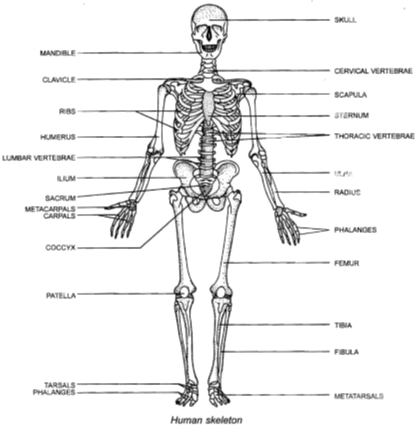
1. Axial Skeleton
It consists of bones of skull, vertebral column and chest.
• Skull : The human skull has 22 bones of which 8 are present in the cranium and 14 on the face. These bones protect the brain and sensory organs.
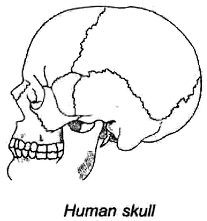
• Vertebral Column : It is made up of 33 ringshaped bones which are called vertebrae. These bones are arranged as follows.
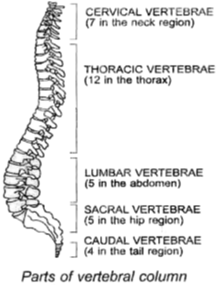
• Chest Bones : The first seven pairs of ribs join the vertebral column at the back and the sternum in front as shown in Fig. The next three pairs of ribs are attached to the seventh pair. The rest of the two pairs of ribs are free. Hence these are known as floating ribs. Chest bone and backbone together form a box called the rib cage. Some important internal parts of our body like the heart and lungs are protected by the rib cage.
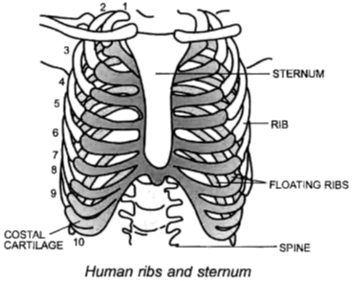
Joints
- Books Name
- CBSE Class 6 Science Book
- Publication
- Param Publication
- Course
- CBSE Class 6
- Subject
- Science
2. Apendicular Skeleton
It consists of two pairs of girdles and the bones of arms and legs.
• Girdles : Girdles are attached to the axial skeleton. These give support to the bones of the limbs. The girdle that supports the bones of arms is called the pectoral girdle. The pectoral girdle is made up of four shoulder bones, two clavicles and two scapulae. Each arm is supported by one scapula and one clavicle. The girdle into which the bones of legs are fitted is called the pelvic girdle.
• Bones of Arms : In the upper arm there is only one bone. It is called humerus. The humerus has a ball-shaped head that exactly fits into the cavity in the pectoral girdle. On the lower side, it has a broad surface which is connected to two bones of the lower arm. TIle broad bone towards the thumb is called radius. The narrow bone that is placed towards the little finger is called ulna. In the wrist, you will find small bones called carpals. The palm consists of five long bones called metacarpals. The fingers consist of small bones called phalanges.
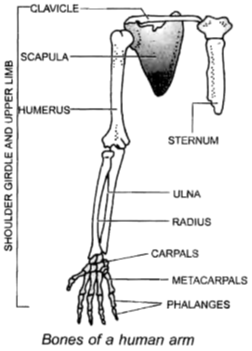
• Bones of Legs : The bone present in the thigh is the longest bone of the body. it is identified as femur. It has a ball-shaped head that can be fitted into a cavity formed by the pelvic girdle. The lower end of the femur is articulated with two leg bones called tibia and fibula. At the knee, there is an additional bone called patella. Down below in the ankle there are the tarsals. The foot is supported by metatarsals and toes of the foot that contain phalanges to support them.
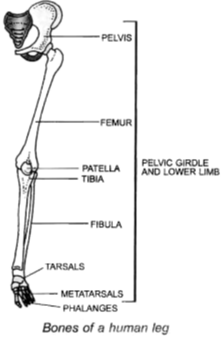
Functions of Skeleton :
l. It supports the body and gives definite shape to it.
2. It helps to protect delicate and vital organs like heart, lungs and brain.
3. With the help of muscles, it helps in the movement of body parts.
4. It is a store house of minerals and is the place for the formation of RBCs.
Gait of Animals
- Books Name
- CBSE Class 6 Science Book
- Publication
- Param Publication
- Course
- CBSE Class 6
- Subject
- Science
Joints
Joints are the place of articulation between two or more bones or between a bone and a cartilage. Due to the presence of a number of joints, the movement of the different body parts and the whole body is possible.
(a) Types of Joints :
(i) Fixed or immovable or fibrous joint : There is no space between the bones. The attached bones are tightly held with the help of white fibrous connective tissue. e.g. Joints of skull bones.
(ii) Slightly movable or cartilaginous joint : It is an articulation between the bones that allows very little movement. e.g. Between bones of vertebrae and pelvic girdle.
(iii) Movable joint or synovial joint : It is a joint which allows the movement of articulating bones such that they can move extensively upon each other.The space between bones is called synovial cavity. This cavity remains filled with a viscous and slippery synovial fluid. These are of following types :
(A) Ball & socket joint : One bone forms a ball like head that fits into a socket formed in the other bone. The bone with head can move nearly in all the directions. e.g. Shoulder joint, hip joint.
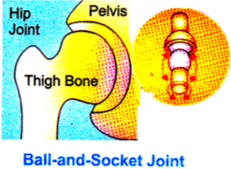
(B) Hinge joint : This joint allows movements in one plane only. e.g. Elbow joint & knee joint.
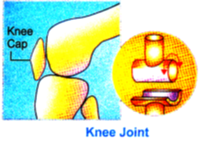
(C) Pivot joint : This joint allows only a rotatory movement of one bone on the other stationary bone. e.g. Atlas and axis vertebrae.
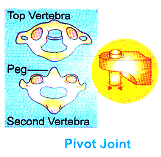
(D) Angular joint / Ellipsoid / Condyloid joint - This allows movement in two directions - side to side and back & forth. e.g. Wrist joint.
(E) Gliding joint : This joint permits sliding movement of two bones over each other, e.g. Carpal in wrist and tarsals in ankle.
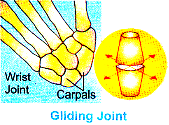

Movement In Different Animals (Part -1)
- Books Name
- CBSE Class 6 Science Book
- Publication
- Param Publication
- Course
- CBSE Class 6
- Subject
- Science
Movement In Different Animals
Movement of Invertebrates
(a) Movement in Amoeba :
Amoeba is an unicellular organism which can move with pseudopodia (false feet).
(b) Movement in Earthworm :
• It lives in moist soil, water and burrows. Its body is elongated, segmented and bilaterally symmetrical. The body of an earthworm is made up of a large number of segments. An earthworm does not have bones. On the lower surface of its body, a number of tiny hair like bristles are present. These bristles help it to get a good grip on the surface of the ground.
• Earthworm doesn’t have bones. It has muscle which help in locomotion with setae (hook like chitinous structure). During movement it first extends the front part of the body keeping the rear portion fixed to the ground with the help of setae. Then it fixes the front end and releases the rear end. It then shortens the body and pulls the rear end forward.
• By repeating such expansions and contractions it can move through soil.
(c) Movement in Snail :
• Snail is a molluscan which doesn’t has bones but has muscles. A shell is present as outer skeleton During movement a thick muscular foot comes out of the shell’s opening.
• The foot produces a slimy substance called mucous. It crawls smoothy on the layer of mucous. The foot is present under its belly. It looks as if the snail is moving on its belly. A trail of mucous is left behind when it crawls on a surface. By the contraction & expansion of the foot muscle it can do slow movement at a substratum.
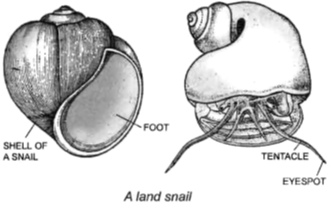
(d) Movement in Cockroach :
• Cockroach is an arthropod which has jointed appendages. It has three pair of legs and two pairs of wings attached to the thorax.
• These legs help it to run very fast. The body of a cockroach is covered with a hard outer skeleton.
• There are two pairs of wings attached to its breast. It can fly only short distances. Thus, a cockroach can walk, climb as well as fly in air.
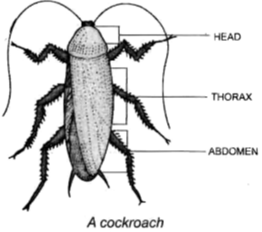
(e) Movement in Vertebrates :
• Animals which possess a backbone or vertebral column are called vertebrates. Examples of vertebrates are fishes, frogs, lizards, snakes, monkeys, cows human beings etc.
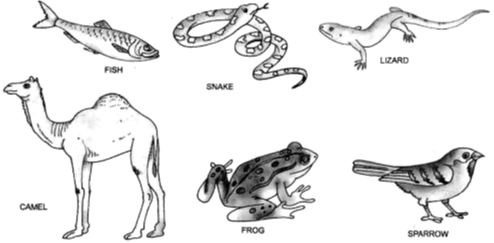
Movement In Different Animals (Part -2)
- Books Name
- CBSE Class 6 Science Book
- Publication
- Param Publication
- Course
- CBSE Class 6
- Subject
- Science
(f) Movement in Fish :
• Fishes are aquatic animals. Head and tail of the fish are smaller than the middle portion of the body. This body shape is called stream lined which is helpful to reduce friction during movement. It has caudal, dorsal (impaired), pectoral, pelvic (paired) fins.
• Fishes have skeletal & muscular system both. During swimming, muscles make the front part of the body curve to one side and the tail part swings towards the opposite side. Then quickly the body and tail curve to the other side.
• This makes a jerk and pushes the body forward. A series of jerks make the fish swim ahead. This is helped by fins of the tail.
• Thus paired fins help in the maintaining balance of body during swimming while impaired provide jerk. Fish lacking bones : In sharks, skeleton is made entirely of cartilage.
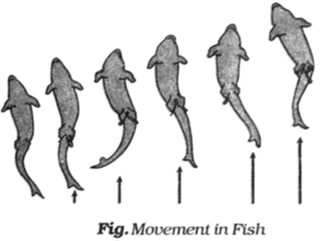
(g) Movement in Snake :
• Snakes are reptiles which can do creeping movement with the help of skeletal and muscular system. Muscles are interconnected to long backbone, ribs and skin. The snakes body curves into many loops. Each loop gives it a forward push by pressing against the ground. These movements occur rapidly in its body that show a very fast movement.
(h) Movement in Birds :
• Birds (Aves) can fly in the air and walk on the ground and some birds like duck can swim in water also. In birds skeletal (with hollow bones) and muscular system are present. Forelimbs are modified into wings. Shoulder bones are strong and breast bones are modified to hold muscles of flight which are used to move the wings up and down. While bones of hind limbs are typical for walking and perching.
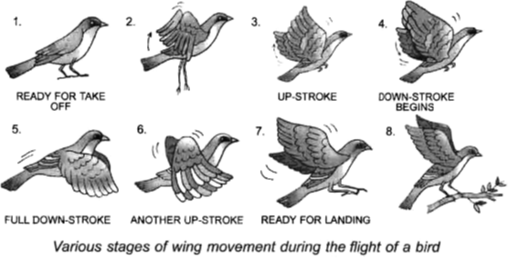
Dislocation
In spite of good natural articulation of bones to one another, sometimes because of a careless movement or a bad fall, the bones at the moveable joints slip out of their position. This is called dislocation. A person who has a dislocated bone may have a sprained or damaged ligament.

 Param Publication
Param Publication
 PathSet Publications
PathSet Publications
